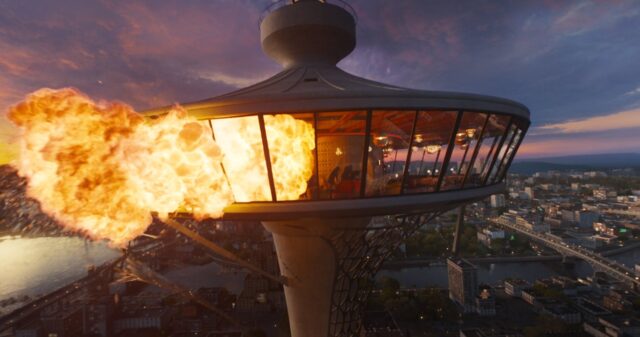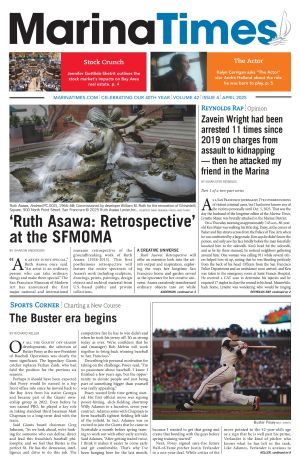When death comes knocking in a Final Destination movie, it’s a Rube Goldberg amalgamation of random items in any given room — a live wire, a loose screw, a faulty garbage disposal that clicks on and off — that all inevitably coincide in a brutal, jolting display of Death’s omnipresent power. As the franchise that began 25 years ago has set out to instill, anyone who’s ever dodged Death’s design has quickly found themselves ensnared in one of his many intricate traps shortly thereafter, thereby proving that nobody, no matter how clever, can ever truly escape their fate. The sixth and latest entry in the series, Bloodlines, takes that notion one step further by snuffing out the traces of all familial ties to the deceased, using their lineage as leverage to decimate its characters in some of the most imaginative onscreen mousetraps yet.
It all begins with a premonition. In the original 2000 film, it was Alex Browning’s (Devon Sawa) dream about the plane he and his classmates were boarding to Paris exploding after takeoff — Flight 180 burning like a shooting star across the New York skyline. Warning his passengers via a full-blown panic attack, Alex manages to save a handful of souls who deboard the plane with him moments before the wheels leave the ground, but their short-lived salvation quickly crumbles under the weight of Death’s wrath. Every single person who got off the plane that day dies shortly thereafter, all in strange ways, all in the order in which they first met their demise in Alex’s vision. In the early aughts era of knife-wielding maniacs, Final Destination stood out as something special by making the killer the mischievous personification of Death itself.
In Bloodlines, the long-awaited return to the franchise, it’s Stefani (Kaitlyn Santa Juana), a college student experiencing recurring nightmares, who is plagued with the sight. Burdened by dreams told from the POV of a 1960s blonde bombshell named Iris (Brec Bassinger), every night Stefani witnesses the implosion of a sky-high restaurant and its many attendees, and every morning she wakes up screaming in terror. When her academia is threatened, Stefani heads back home in search of rest and respite, and instead finds answers to questions she didn’t even know she was looking for. It turns out that Iris is her grandmother, and Stefani’s nightly visions have been offered up as a warning sign: Iris was supposed to die in that tower, her vision saved her life and dozens of others, and as a result, her bloodline was never supposed to exist. Now, years later, Death is finally circling back around to collect what he’s owed, and Stefani’s family is up next on the slab.
Directed by Zach Lipovsky and Adam B. Stein, from a script by Guy Busick and Lori Evans Taylor (who developed the story with Jon Watts), Bloodlines is not only blowing up box offices around the world, it also boasts some of the best gags in the entire series. The co-directors knew that they wanted to go big for their installment, and that meant putting together a top-notch crew with both imagination and grit. LA Weekly had the privilege of speaking with some of the bold and brilliant masterminds responsible for bringing such intensity to the screen, including Special Effects Coordinator Tony Lazarowich, VFX Supervisor Nordin Rahhali, and Stunt Coordinator Simon Burnett. Together, these elite few told us all about how they accomplished some of the very best effects sequences in Final Destination: Bloodlines.
(Warning: spoilers abound below!)
THE SKYVIEW MASSACRE
If there’s one thing that a Final Destination movie is gonna do, it’s absolutely crush a highly intrinsic opening scene centered around an epic set piece. “The franchise is known for their deaths, but they’re probably more known just for that opening act — that whole premonition,” says VFX Supervisor Nordin Rahhali. “No one drives behind log trucks anymore just because of the movie, right?”
In Bloodlines, that set piece is the Skyview, a fine dining establishment that doubles as an observation tower (think the Seattle Space Needle), complete with an all-glass outdoor elevator that allows its patrons to watch the city grow small under their feet as they rise. Standing on the outer deck overlooking the city, Iris watches as an unattended schoolboy tosses pennies off of the edge of the building, setting in motion the typical domino effect that has come to make these movies so famous. One of the pennies gets sucked into an air vent and becomes jammed, a glass shard falls off of one of the many chandeliers and pierces the transparent glass dance floor below, and before you know it, the entire restaurant is engulfed in flames.

“It took a lot of effort on everybody’s part, because if you think about it, there’s a million different things that happen within that first sequence,” recalls Special Effects Coordinator Tony Lazarowich. “You’ve got people going up in a shaky elevator, and then you go into the whole sequence of the fire, and the floor breaking, and the elevator cutting the guy in half, and on and on it goes.”
Bloodlines began conceptualization shortly after lockdown and right before the film industry strikes, and was eventually brought to fruition after a long uphill battle. In order to better communicate ideas to each other from afar, co-directors Lipovsky and Stein used an innovative approach to their vision: they acted out the gags and sent the crew members videos of their efforts. “You’d actually get in your email a video of the two of them being like, ‘Hey I’m Adam!,’ ‘Hey I’m Zach!’ ‘And this is what we’re thinking today, we run along this thing here, and do this!’” remembers Stunt Coordinator Simon Burnett. “When you’re head of a department, you have your storyboards and your script, which helps you, but you’re always trying to pester the director and ask, ‘What do you really want?’ But to have them physically go through it with all this enthusiasm, I think that kept a lot of this alive.”
Once the restaurant scene was drawn out in storyboards and displayed through the directors’ many videos, Rahhali invoked the power of visual effects to map out the parameters of the entire sequence ahead of time using previsualization. “Basically, we take the previs, get it to a point where the directors feel that the action is good, and that they’re getting the camera angles that they want, and then we show the whole team and the studio, and they give the thumbs up,” explains the VFX wizard. “And then we try to figure out how we’re going to execute it. Like, ‘We need to be able to lift up this part of the ceiling over the dance floor so we can get the crane in there,’ or ‘We need access to this,’ – it’s a good collaborative effort. It’s also a really helpful tool to figure out the vision that the directors want to have for the sequence.”
Rahhali also employed a “Volume Wall,” a relatively new technology that is essentially a giant TV screen, one which hugs the set and serves as a backdrop to sell the illusion that the restaurant these guests populate is actually several stories off of the ground. Stacked modular LED panels create a 240-degree, 30-foot high, 8-foot off-the-ground wall that plays video, providing a believable backdrop that’s so startlingly accurate, it even reacts to lights correctly. At one point, Iris’s beau picks up a few glasses of free champagne and hands one over. “Those champagne glasses are reflecting that whole background environment and doing it properly,” says Rahhali. “They’re refracting. It’s upside down, and you’re getting all these beautiful reflections, and that’s because the background is real.”
As the beats of Death’s design unfold step by step, the base of the dance floor gives out, and the entire restaurant slants to one side, sending people tumbling out of the building and into the sky. “We did a Star Trek gag,” Lazarowich says with a grin. “That classic, the building is starting to break away, and we see the wine bottle start to roll, and we see the mints rolling? We did that with a set that was absolutely dead flat, horizontal. We had about 22 different wires on tables and chairs and on people, and so I had to have a whole bunch of special effects people pulling on wires, as well as actors giving the impression that they’re sliding sideways.”
What starts out as an endearing romantic proposal quickly devolves into a night of terror as Iris and her fellow Skyview attendees watch as myriad explosions set the room ablaze. Fireballs soar and tables burn while everyone desperately searches for a way out of the building. “We’d have up to five or six people burning,” says Stunt Coordinator Burnett, “As well as other people running through fire.”
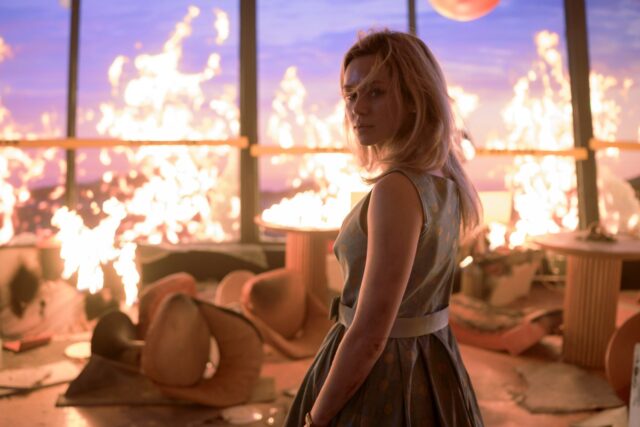
While the production team built what was essentially a fireproof set, Lazarowich installed a type of fiery sprinkler system that he could use to turn the flames on and off at will. Todd Masters’s Masters FX covered the dummies being set ablaze, as well as providing the bloody makeup needed for the injured patrons. The makeup department worked closely with the special effects department to supply the appropriate number of fake bodies, and the stunt department provided the daredevils quite literally willing to walk through fire. One elderly woman stands out amongst the rest, as she rushes past the leading lady during the height of all of the chaos, to the forefront of the screen, petite and sizzling, her entire body covered from head to toe in red hot flames. Apparently, the crew on Bloodlines actually set the record for the oldest person ever set on fire in a film — an honor that everyone involved takes to heart.
“We had a 70-year-old woman named Yvette Ferguson that did our biggest fire burn,” says Burnett, “And we had her covered from head to toe in burn gel.” Ferguson, a seasoned actor, has been performing stunts for movies and television her entire life, but this occasion marked her very first time dealing with fire. The burn gel covering her entire body made it possible for her to be lit up for as many rehearsals and minutes onscreen as deemed necessary (“We set her on fire probably eight or nine times before we ever came to set,” reports Lazarowich), and Rahhali’s visual effects removed the glossy look on her skin in post-production to make her burning appear more believable.
Film sets are known for long, grueling hours, but when a veteran stunt performer is willing to set herself on fire multiple times in the name of cinema, it undeniably sets the standard for the entire cast and crew filming that day. “No one can complain about anything at all,” Rahhali laughs. “It’s like, this lady is going hard.”
TATTOO PARLOR TRICK
Shortly after the untimely death of his father, tattoo artist Erik (Richard Harmon) takes a reprieve from his cousin Stefani’s rantings about death stalking their family by covering a closing shift for his boss at the tattoo parlor. Alone after hours, Erik decides to give himself a small tattoo on his arm to remember his old man. But in the eyes of the grim reaper, all this poor lost soul has done is provide the perfect setting for one of his most gnarly sequences yet: death by septum piercing.
A ceiling fan in the center of the tattoo shop is decorated with chains that hang down like a canopy to set the scene. When one chain swings loose, it inadvertently latches on to Erik’s septum piercing, and as the fan spins, the chain wraps around the fan, growing tighter and tighter, pulling Erik up toward the blades. Seeing what’s happening and feeling powerless to stop it, he tries to wrangle himself free, but Death has other plans.
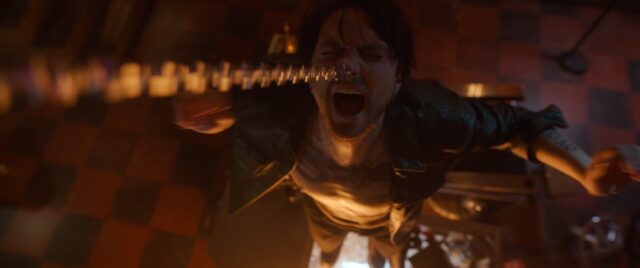
“The most important discovery of that sequence was actually made by our producer slash creator, Craig Perry,” says Burnett. “We had a stunt guy ready to go, and we tried a million different versions of hanging somebody by their nose, everything from magnetic chains that release, to all sorts of things. But the tricky part was just keeping it on his nose.”
“There were a few things designed by our makeup team,” states Rahhali, “But it all had blue, or something where we would have to paint out his face. We all kept looking at it going, ‘That’s too hard. There’s gotta be a better way of doing it.’”
“Craig Perry, our executive producer, came in one day, kind of in the fifth hour, and said, ‘There’s this sleep apnea mask I wear,’” recalls Burnett. “They’re basically like a cone with mesh that you shove into your nose that allows you to breathe at night time. And by having these things, which I’ve never seen before, we were then able to glue an appliance to the nostril sleeves, for lack of a better word. We also did a magnetic chain loop, so that if he were to fall, the chain would come undone.”
“Overnight, he basically saved the visual effects on that one, because he suggested this device,” points out Rahhali. “They just attached it to the inside, and all of the tugging that you see is real. We really only had minor cleanup to do.”
While in the midst of his battle against fate, Erik accidentally knocks over a bottle of flammable liquid, and before long, a trail of fire scorches the floor under his feet, turning his already desperate situation into a fully blown inferno.
“Richard was so game,” says Lazarowich with a smile. “All of it’s real fire. For the whole sequence, the whole thing is real fire. I’m going to say that other than probably one shot for sure was a stunt double, but Richard was the guy climbing it all. Richard was the one fighting with the flames in between his legs. The only one that wasn’t him was when he comes flying off and swings and lands in the fire. That just couldn’t be Richard.”
Even Burnet, an accomplished coordinator who has been involved with the series since the very first film (“I was a young stunt guy in the very first one, and then by the time we got to the fifth one, I was the assistant stunt coordinator, and now, I’m the stunt coordinator”) was impressed with Harmon’s willingness to perform so many dangerous moments himself. “My job becomes so much easier when you have a straightforward guy that isn’t precious, and Richard’s not precious. So, it was good. It was fun.”
MRI MACHINE MUTATION
Running out of time and short on ideas on how to defeat Death’s plan, Erik tells his brother Bobby (Owen Patrick Joyner) that the only way to get rid of their family curse is to temporarily unalive Bobby so they can alter Death’s pattern, thus hopefully putting an end to its design. Erik’s plan is to wheel his brother Bobby into the first empty room that he can find at a nearby hospital, trigger his brother Bobby’s peanut allergy with a peanut-themed snack, allow him to pass on, and then immediately call a doctor to revive him. While waiting, however, Death shows these boys that tinkering with his plans isn’t going to do anything except piss him off — and as a result, set in motion an even more complicated death trap than originally intended.
In a manner not unlike a certain gymnast’s demise in Final Destination 5, Erik winds up being sucked into the MRI machine via his many magnetic body piercings, along with the wheelchair he had haphazardly set up in front of the device. His entire body becomes crunched in half so that he is bent backward like a pretzel, with only his arms and legs sticking out of the machine.
“When we were talking about the sequence, and they had the storyboards, and they showed the chair going through the skull inside the MRI machine, everybody in the room was like, ‘Ew, yikes,’” Lazarowich remembers. “My philosophy with all of this, on a movie like this, is if you can make the crew groan, then I think you got the right thing. That’s the right gag to do. That’s the right stunt to do. Because we’re the hardest judges of it all. It’s like a comedy. If we laugh, then it’s going to be funny. Because we’re so jaded by it all.”
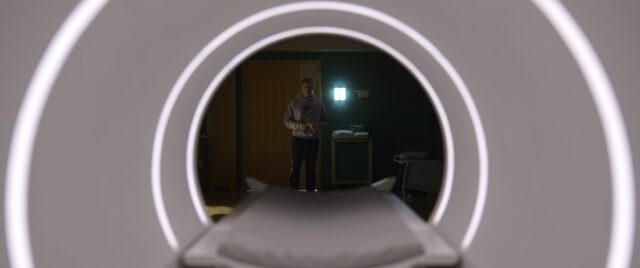
“That was one of the first deaths we shot,” says Rahhali, “And that one was really fun to put together. You obviously had the wheelchair. So all of the practical gags of the piercings being pulled and all that, that was stunts in SFX. They had monofilament wire that was pulling little blood bags, and we added more blood [with VFX] and all that, but they did the lines off of his nipples and his ears. We were able to just paint that stuff out. His nose ring, we bent in visual effects. Obviously, the one down below, the Prince Albert, was practical to him.”
Rahhali continues, “Stunts then took over for the wide shot where he gets thrown into the MRI. We added the wheelchair that was behind him, so that was all CG as it was being pressed up against him, and his body starts to bend and go inside. We had the same stunt guy that hit the machine, and then we obviously took him out of the rig, and he became Richard. But Richard was laying on the upper half of the MRI, so his body was on the inside, and he was being held from the top, and then the other stunt guy was laying on his stomach just underneath. It was a really thin board that Richard was on top of, and the stunt guy was on the bottom. So that when you line them up, they look like the same person, except they were able to be puppeteered from the inside. You had them being pulled on equally, top and bottom. And then the body’s looking like the back is starting to break, because we’re covering it with the wheelchair and animating all the breaks, which worked really well. So that one was a cool combination of all the different disciplines.”
With a giant skull tattoo covering Erik’s backside, and his gruesome death ending with metal poles shoved through his abdomen, the end result looks strikingly similar to the movie poster for Final Destination 5. “It was art directed to look like the poster,” Rahhali admits. “It got very bloody.”

